Assignment 4 Report
Introduction
Experience and master the use of AEDs in life-threatening situations through our immersive VR training application, equipping you with the confidence and skills to potentially save lives in real-world emergencies.
Description of the application
Our team has developed a Virtual Reality (VR) application specifically designed to educate and train users on the utilization of AEDs (Automated External Defibrillators). By harnessing the immersive and interactive capabilities of VR technology, we have crafted a lifelike simulation environment for AED usage. With the VR headset, users can immerse themselves in training scenarios, learning the critical steps to employ an AED during emergencies. Our application provides real-time feedback and guidance throughout the entire training process, ensuring not just understanding, but mastery of each step. The primary objective of our application is to deliver a comprehensive and engaging learning experience on the correct use of AEDs. Within this virtual realm, users can interact with simulated AED devices using hand controllers. They are trained to swiftly assess a patient's condition, locate the AED based on visual signs like markers or signposts, place the electrode pads accurately, and activate the AED for defibrillation.
In the context of the chosen scenario, which is educating and training individuals on the use of AEDs, this VR application holds immense significance.
- According to the research done by AEDUSA (2020), the survival rate for patients receiving their first defibrillation within three minutes stands at a staggering 74%. By educating the general population on how to use AED’s, more people will be able to act quickly and potentially save an individual undergoing cardiac arrest.
- Traditional AED training involves static dummies and lacks the immersive, real-world context that VR can provide. This application offers a highly immersive and realistic training environment so that the user can learn not only how to use the AED but be comfortable using them in high stress scenarios. Users can practice using an AED on a virtual body undergoing cardiac arrest in a controlled yet realistic setting, preparing them better for actual emergencies.
- VR training can enhance users' confidence in their ability to use AEDs. Quite often in stressful situations, people are afraid to act in emergency scenarios as they do not want to get involved and potentially cause more harm to the individual needing help. This common psychological phenomenon is known as Self-Efficacy, proposed by psychologist Bandura in 1994 (Bandura 1994). After users undergo training provided by the application, they feel confident in handling the device in actual emergencies.
- While this application is as accessible as training videos, it has an additional advantage of providing an immersive experience akin to an on-site training guide. Users will have the flexibility to practice at their own pace. According to a study by Stice (1987) which is based on the Kolb's Learning Cycle (Kolb & Hay Resources Direct 2007), practice is typically more memorable than merely watching videos.
- The VR application is available for a broad range of individuals, from the public to healthcare professionals, making it a versatile tool for AED training. It can be utilized in schools, workplaces, medical stores, community centers, healthcare institutions, and shopping malls.
After completing the AED training using this VR application, users will have a deep understanding of how to properly use an AED in various scenarios. Users will be well prepared to respond effectively to cardiac emergencies, knowing when and how to initiate AED use and administer life-saving treatment. The user will also gain the confidence to take swift and decisive action in high-stress situations, potentially increasing the chance of survival for individuals experiencing cardiac arrest (US CPR online 2022).
Description of the interface solution
The interface solution for the VR application designed for AED training plays a crucial role in enhancing the overall learning experience.
- The VR interface immerses users in a 3D virtual environment. Users were wearing a VR headset that provided a wide range of views, creating a sense of presence within the training scenarios. This immersive environment mimics real-world settings, such as public spaces or medical shops, where AED usage might be required.
- VR allows for interactive learning. The user can physically interact with the virtual AED and practice the necessary steps, including electrode placements.
- VR provides a safe and repeatable training environment. Users can make mistakes and learn from them without consequences, ensuring that they are well-prepared when faced with an actual emergency.
- VR technology can engage a wide range of users, from ordinary people to healthcare professionals. Its immersed nature captures the user's attention, makes learning more enjoyable, and increases motivation (Start Beyond 2020).
- VR serves as a bridge between theoretical knowledge and real-world application. It allows users to apply what they’ve learned in a controlled yet realistic manner, bridging the gap between classroom or online training and an actual emergency (VR 2021).
Interaction Design
Interaction design plays an important role in VR applications designed for AED training.
- As previously mentioned, according to Kolb's learning cycle theory, hands-on practice is more impactful than merely watching videos (Kolb & Hay Resources Direct 2007).
- Interaction is essential for users to develop the skills required to operate an AED effectively. AED usage involves a series of steps, such as picking up the device, attaching electrodes, and placing it on the patient's body. Through interaction, users can master and practice these skills in a simulated environment.
- Interaction creates a realistic simulation. Users can physically pick up and manipulate the virtual AED devices, mimicking real-world actions.
- Interaction enables users to receive real-time feedback on their actions. For example, when attaching electrodes, the application can provide guidance.
- Interaction enhances knowledge retention and the transfer of skills. Active participation with feedback helps users remember the correct procedures and confidently apply them when needed.
Storyboard:
- The initial setup will have the user placed in a real world setting with an individual in need of assistance. The user will have an HUD attached to their left hand giving them step by step instructions.

- Click the button to check the person health status.
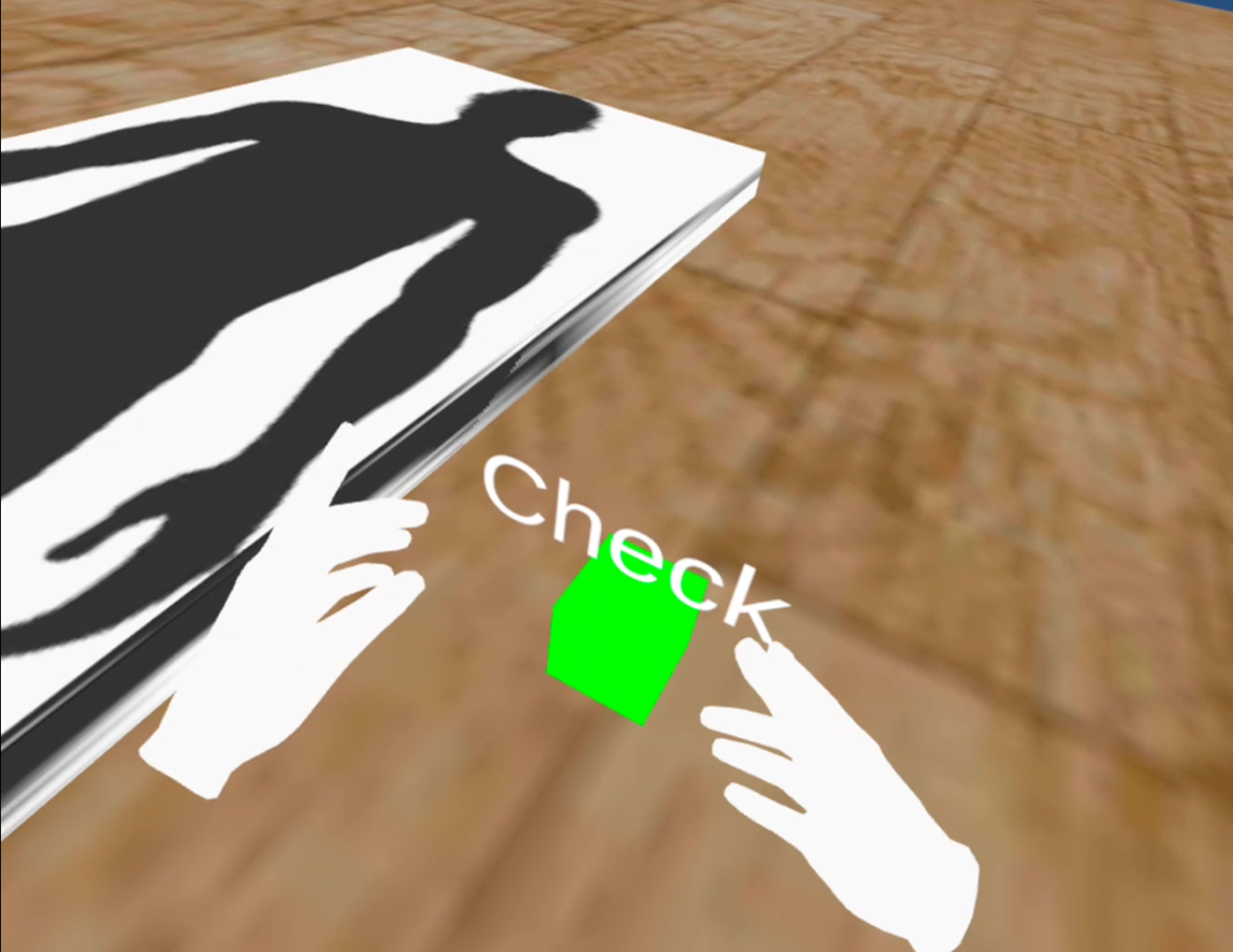
- The person needs AED immediately, so go and find AED.

- Place the AED to a suitable place.
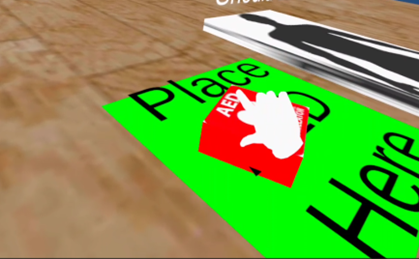
- Open the AED.

- Put the Electrode Pads to the correct place.
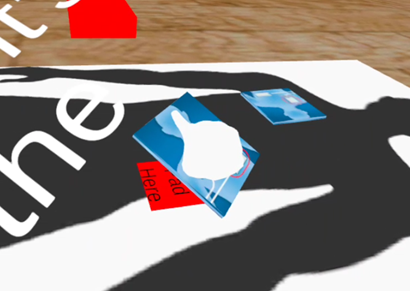
- Press the button to deliver the shock.

Initial technical Development
Technical development:
Development Platform: Unity 3D.
Hardware: Oculus Quest.
3D Modelling & Assets:
For a more realistic environment, we integrated texture materials, such as those from Yughues Free Metal Materials and Yughues Free Wooden Floor Materials. These textures provided depth and realism to our virtual environments.
We are currently using a cube as a placeholder for the human body, which will be replaced with a detailed human model in the next stage to further enhance realism.
User Interface:
Our application boasts a unique HUD (Heads-Up Display) bound to the user's left hand. This dynamic UI provides instant instructions and feedback, enhancing the immersive learning experience. The HUD concept was inspired by popular wearable tech interfaces, like smartwatches.
User Interaction:
The user interacts with buttons and can grab and drop items through the handle and triggers on the handle.
Future Technical Development:
The next phase will introduce a more realistic human body model and integrate voice guidance to simulate more realistic situations.
Specific interface technology:
In the development of the VR application used for AED training, A widely used and recognized interface technology for VR applications is the Oculus platform, specifically the Oculus Rift or Oculus Quest.
Oculus Quest: The Oculus Quest is a standard VR headset. It does not require a PC or an external sensor. It offers portability and convenience, allowing users to engage in VR experiences without being tethered to a computer. The Quest provides a rich and immersive VR experience with hand tracing and gesture recognition. The Oculus headsets offer precise tracking of user movements, including head and hand tracking. This ensures that interactions in virtual environments are accurate and realistic.
Initial 3D Models
The 3D models used and planned to use in the applications:
- Virtual AED Device: This 3D model represents a virtual Automated External Defibrillator (AED).
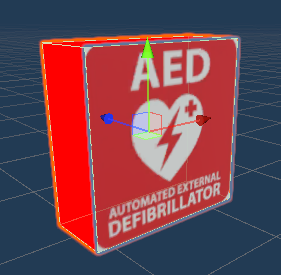
The picture is from mega sticker store: (https://megastickerstore.com.au/products/first-aid-sticker-aed-automated-external-defibrillator-sticker-warning-signs-set)
2. 3D Game Object box: It is composed of multiple blocks and is used to simulate the box where AED is stored in real life. 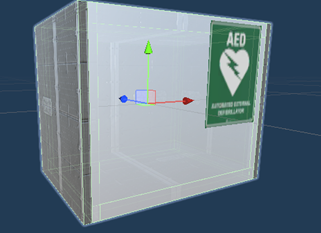
Material from Yughues Free Metal Materials: (https://assetstore.unity.com/packages/2d/textures-materials/metals/yughues-free-metal-materials-12949)
3. 3D model cube: used as a medium to assume the human body to place the electrode and perform the task. This object will be replaced by human model in next stage.
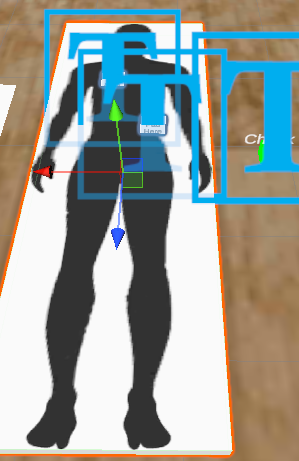
The picture is from shutter stock: (https://www.shutterstock.com/zh/image-vector/men-body-icon-vector-illustration-male-1921828673)
4. 3D cubes Electrode Pads: A 3D model of AED electrode pads used to simulate attaching electrodes to the virtual cube (imagined as a patient body).
5. 3D Object AED opened: Consists of two Electrode Pads, a button and base to simulate what a real AED looks like when opened.
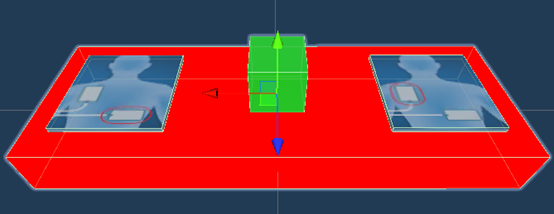
6. HUD bind on the left hand: Bind the HUD to the left-hand model so users can see instructions like using the watch.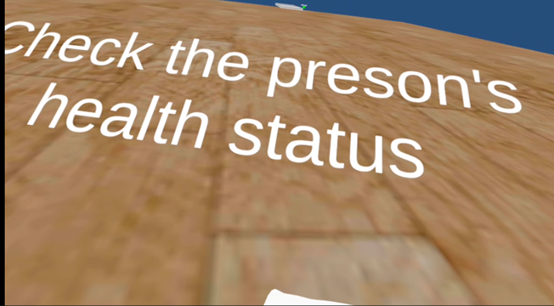
7. 3D Plane for AED: Used to place an unopened AED and press the button to switch it to the open state.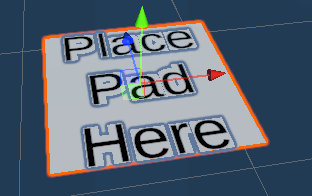
8. 3D Plane for Pads: Used to detect whether Electrode Pads are placed in the correct position.
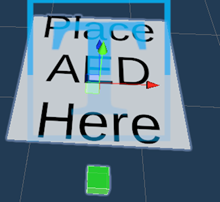
9. Floor: used to allowed user to walk around.
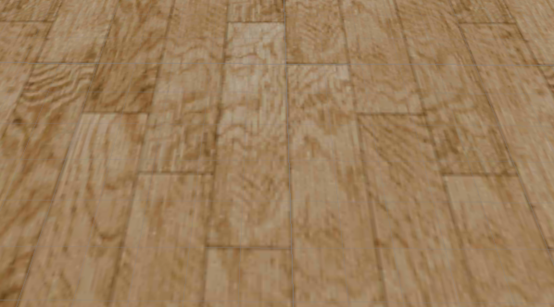
Material is from Yughues Free Wooden Floor Materials: (https://assetstore.unity.com/packages/2d/textures-materials/wood/yughues-free-wooden-floor-materials-13213)
Conclusion
The interface solution of our VR application leverages the immersive capabilities of the Oculus Quest headset and creates a realistic and interactive learning experience. The application utilizes 3D models to replicate AED devices and training environments, allowing users to practice their AED operation skills in a safe and controlled environment. The combination of VR technology, interaction, and a 3D model fosters skill development, enhances knowledge, and ultimately equips users with the confidence and competence to respond effectively in a real-life cardiac emergency.
Reference list
AEDUSA 2020, What Is The Defibrillator Survival Rate | aedusa.com, https://www.aedusa.com/knowledge/, viewed 6 October 2023, <https: www.aedusa.com="" knowledge="" what-is-the-defibrillator-survival-rate="" #:~:text="An%20AED%20is%20a%20relatively">.</https:>
Bandura, A 1994, ‘Encyclopedia of mental health’, Self-Efficacy, vol. 4, Academic Press, no. 4, pp. 71–81, viewed 6 October 2023, <http: happyheartfamilies.citymax.com="" f="" self_efficacy.pdf="">.</http:>
Kolb, DA & Hay Resources Direct 2007, The Kolb learning style inventory : LSI workbook, Haygroup, Boston, Mass.
Start Beyond 2020, Start Beyond — Three reasons VR is the best way to deliver life-saving First Aid Training, www.startbeyond.co, viewed 6 October 2023, <https: www.startbeyond.co="" media="" three-reasons-vr-is-the-best-way-to-deliver-life-saving-first-aid-training="">.</https:>
Stice, JE 1987, ‘Using Kolb’s Learning Cycle to Improve Student Learning’, Engineering Education, vol. 77, no. 5, pp. 291–96, viewed 6 October 2023, <https: eric.ed.gov="" ?id="EJ357319">.</https:>
US CPR online 2022, What Are The Benefits of AEDs at Workplace, mycpr-new.webflow.io, viewed 6 October 2023, <https: www.uscpronline.com="" blog="" benefits-of-aeds-at-workplace#:~:text="Having%20an%20AED%20in%20the%20workplace%20can%20help%20save%20lives">.</https:>
VR, P 2021, Automated External Defibrillator VR Training (AED), PIXO VR, viewed 6 October 2023, <https: pixovr.com="" vr-training-content="" aed-freerangexr="">.</https:>
Files
Get AED Training
AED Training
| Status | Prototype |
| Author | Quintus033 |
| Genre | Educational |
More posts
- Assignment 5 ReportOct 27, 2023